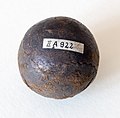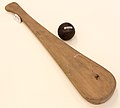Pelota
Pelota (also Pelota Vasca ) is a setback game of Basque origin. Two players or two teams of two take turns hitting a ball against a baffle, the frontón , until one side scores a point according to the rules. The winner is whoever reaches a certain number of points first. The focus of the game is always a ball, but the acceleration instruments vary historically and locally between the bare hand, a pickguard and a pointed basket with a catch and throw function. Written rules for a large number of different forms of competition are only known from the 19th century.
Pelota has the character of a folk festival and has traditionally played a central role in public life in the Basques . The playing fields in front of the Frontón are between 35 and 60 meters long and up to 15 meters wide. The pelotas are also known as pelotari .
Varying percussion instruments
Pelota exists mainly in the variants Pelota a Mano , Pelota a Pala and Cesta Punta . In pelota a mano , the ball is hit with the bare hand. This is the most widespread and, above all, most popular style of play in northern Spain today. Pelota a Pala players use a simple wooden stick called a pala or paleta (similar to squash ). The game variant Cesta Punta is most commonly played in the United States , where it is also known as Jai Alai (Basque for happy game ). A glove connected to an elongated basket serves as a bat, hence the name Cesta Punta , Spanish for "pointed basket" (Basque xistera ).
Pelota play equipment in the Berlin Museum of European Cultures
Pointed basket (Xistera) for Jai Alai
The cue ball
The pelota soccer ball, especially the one for pelota a mano , is usually made of leather or rubber, is filled with a wooden core and several layers of fabric or latex, and weighs around 100 grams. It is handcrafted so that each individual ball has its own characteristic playing properties. At Pelota a Mano , the players choose the balls from an existing number according to personal preferences. There are still places in the Basque Country where the balls are handcrafted with different characteristics in family businesses. In Sestao , the core of the balls today consists of a thin, extremely elastic latex tape that is wrapped into small, hard balls. They are then wrapped with pure wool and then with cotton cords. Finally, the ball is covered with goat skin. All balls weigh between 103 and 107 grams. Pelota a Pala is partly played with rubber balls that appeared after the discovery of America.
Pelota fields - focal points in the Basque Country
distribution
“Every tourist who comes to the Basque Country,” says Xabi Franchez Apeztxea, “encounters a frontón , even in the smallest villages , the place with a concrete impact wall on which pelota is played. Anyone who watches a contienda de mano , i.e. a pelota game played by hand, will be captivated by how the players with all their might the pelota , this small rubber or leather ball with a diameter of about six centimeters and a weight of 100 grams, hurl against the wall of the frontón . They play with almost bare hands, only in some places lightly protected with plasters and small patches of fabric. ”There is hardly a place in the Basque Country where the fiestas do not have a pelot tournament.
The game is now played in various forms as an indoor sport in the Spanish and French Basque Countries and in neighboring areas, as well as in Mexico , Argentina , Uruguay , the Philippines ( Manila ) and parts of the United States (especially Florida ).
In 1900 , like croquet and cricket , pelota was a sport for the first and only time at the Olympic Games in Paris. In 1924, 1968 and 1992 it was only a demonstration sport .
Pelota a Mano is a very popular year-round sport in the Basque Country, where it has a similar status to football. Pelota has also been played professionally since the 20th century . The annual finals of the professionals are followed closely across the Basque Country. Some television stations from northern Spanish regions interrupt their regular programs to broadcast pelota games. At over 60 percent, the audience ratings for the final round surpass those of the Basque football derby between Athletic Bilbao and Real Sociedad San Sebastián . While the games are on the pelota Frontones as in the bars betting with partly high amounts completed. Some of the most outstanding players, according to Apeztxea, have become myths among the Basques, for example Julián Retegi or Atano III in the middle of the 20th century .
Web links
- International Pelota Association (Spanish, Basque, French, English)
- Basque Pelota Association (Spanish, Basque)
- Pelota a Mano website (Spanish)
Remarks
- ↑ Pelota - the rules ; accessed on November 26, 2018.
- ↑ Mark Kurlansky: The Basques. A little world history. Munich 2000., p. 414.
- ↑ Xabi Franchez Apeztxea: Pelota - the Basque ball game. In: Reiner Wandler (Ed.), Euskadi. A reader on politics, history and culture in the Basque Country. Berlin 1999, p. 187.
- ↑ Xabi Franchez Apeztxea: Pelota - the Basque ball game. In: Reiner Wandler (Ed.), Euskadi. A reader on politics, history and culture in the Basque Country. Berlin 1999, pp. 187-189. "In the French Basque Country, pelota bets are not allowed, but in the four provinces in the south - Araba, Bizkaia, Gipuzkoa, Nafarroa - as well as in the neighboring region of La Rioja, where a lot of pelota is played, they are simply part of it." Ibid, p. 187)











